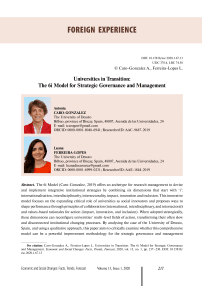Universities in transition: the 6I model for strategic governance and management
Автор: Caro-Gonzalez Antonia, Ferreira-Lopes Luana
Журнал: Economic and Social Changes: Facts, Trends, Forecast @volnc-esc-en
Рубрика: Foreign experience
Статья в выпуске: 1 т.13, 2020 года.
Бесплатный доступ
The 6i Model (Caro-Gonzalez, 2019) offers an archetype for research management to devise and implement integrative institutional strategies by combining six dimensions that start with ‘i’: internationalisation, interdisciplinarity, intersectorality, impact, innovation and inclusion. This innovative model focuses on the expanding critical role of universities as social innovators and proposes ways to shape performance through principles of collaboration (international, interdisciplinary, and intersectoral) and values-based rationales for action (impact, innovation, and inclusion). When adopted strategically, these dimensions can reconfigure universities’ multi-level fields of action, transforming their often slow and disconnected institutional changing processes. By analysing the case of the University of Deusto, Spain, and using a qualitative approach, this paper aims to critically examine whether this comprehensive model can be a powerful improvement methodology for the strategic governance and management system of university research. The research unveils the way the model performs in practice and unfolds its key performance features and critical success factors while addressing the fundamental challenges and barriers faced by universities nowadays. The research carried out suggests that a holistic view of research management can better inform research policy, support decision-making, and generate more focused and integrative implementation of the research strategy. Based on this research strategy framework at a specific university, further implementations and assessments of the model in other institutions and settings will contribute to further explore the potential of the 6i model as a comprehensive strategic design with which universities can steer their priorities, activities and role within local, regional and global ecosystems
Research policy, research management, systems thinking, interdisciplinarity, research excellence, social impact, internationalisation
Короткий адрес: https://sciup.org/147225438
IDR: 147225438 | УДК: 378.4 | DOI: 10.15838/esc.2020.1.67.13
Список литературы Universities in transition: the 6I model for strategic governance and management
- Hansson S., Polk M. Assessing the impact of transdisciplinary research: The usefulness of relevance, credibility, and legitimacy for understanding the link between process and impact. Research Evaluation, 2018, vol. 27, no. 2, pp. 132–144. Available at: https://academic.oup.com/rev/article/27/2/132/4855909 (accessed October 29, 2018).
- Martin B. Are universities and university research under threat? Towards an evolutionary model of university speciation. Cambridge J Econ, 2012, vol. 36, no. 3, pp. 543–565. Available at: http://web.a.ebscohost.com.proxy-oceano.deusto.es/ehost/pdfviewer/pdfviewer?vid=1&sid=e2d60e4d-d2ad-4ac9-8b0cd2064d9eebc3%40sdc-v-sessmgr03 (accessed December 17, 2018).
- Thoenig J.-C., Paradeise C. Strategic capacity and organisational capabilities: a challenge for universities. Minerva, 2016, no. 54, pp. 293–324. Available at: https://link.springer.com/content/pdf/10.1007%2Fs 11024-016-9297-6.pdf (accessed May 27, 2019).
- Caro-Gonzalez A. The “6i Research Model”: Evolution of an innovative institutional STI policy framework at the University of Deusto. fteval J Res Technol Policy Eval, 2019, no. 48, pp.105–113.
- Akkerman S.F., Bakker A. Boundary crossing and boundary objects. Review of Educational Research, 2011, no 81 (2), pp. 132–169. Available at: http://rer.aera.net (accessed February 7, 2019).
- Engeström Y. Learning by Expanding: an Activity-Theorical Perspective. Helsinki: Orienta-Konsultit Oy, 1987.
- Wenger E. Communities of practice: learning as a social system. Syst Thinker, 1998, no. 9 (5), pp. 2–3.
- Akkerman S.F., Bakker A. Boundary crossing and boundary objects. Review of Educational Research, 2011, no. 81 (2), pp. 132–169.
- Woldegiyorgis A.A., Proctor D., De Wit H. Internationalization of research: key considerations and concerns. Journal of Studies in International Education, 2018, no. 22 (2), pp. 161–176. Available at: https://doi.org/10.1177/1028315318762804 (accessed February 11, 2019).
- Abramo G., Andrea C.D., Solazzi M. The relationship between scientists’ research performance and the degree of internationalization of their research. Scientometrics, 2011, no. 86, pp. 629–643. Available at: https://link.springer.com/content/pdf/10.1007%2Fs11192-010-0284-7.pdf (accessed February 28, 2019).
- Oleksiyenko A. Global portfolios and strategic international partnerships of a major research university. Library and Archives Canada=Bibliothèque et Archives Canada, 2009. Available at: https://oceano.biblioteca.deusto.es/primo-explore/fulldisplay?docid=TN_proquest304342683&context=PC&vid=deusto&lang=es_ES&search_scope=default_scope&adaptor=primo_central_multiple_fe&tab=default_tab&query=any,contains,Global portfolios and strategic inter (accessed May 9, 2019).
- Burgess M., Garnett V., O’Connor A., Ohlmeyer J. Interdisciplinarity for Impact – Workshop Report. Dublin, 2016. Available at: https://www.tcd.ie/trinitylongroomhub/assets/documents/2018-FinalReport.pdf (accessed April 1, 2019).
- Kwiek M. The European research elite: a cross-national study of highly productive academics in 11 countries. Higher Education, 2016, vol. 71, no. 3, pp. 379–397. Available at: http://link.springer.com/10.1007/s10734-015-9910-x (accessed March 11, 2019).
- Mårtensson P., Fors U., Wallin S.-B., Zander U., Nilsson G.H. Evaluating research: a multidisciplinary approach to assessing research practice and quality. Research Policy, 2016, vol. 45, no. 3, pp. 593–603. Available at: https://www.sciencedirect.com/science/article/pii/S0048733315001845 (accessed November 15, 2018).
- Miettinen R., Tuunainen J., Esko T. Epistemological, artefactual and interactional–institutional foundations of social impact of academic research. Minerva, 2015, vol. 53, no. 3, pp. 257–277. Available at: http://link.springer.com/10.1007/s11024-015-9278-1 (accessed May 27, 2019).
- Quantifying the social impact of research and medical journals. Lancet, 2014, vol. 384, no. 9943, p. 557. Available at: https://linkinghub.elsevier.com/retrieve/pii/S0140673614613490 (accessed October 1, 2018).


